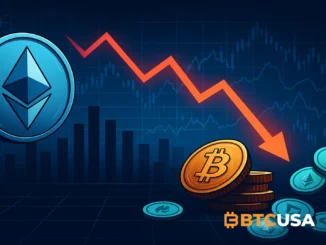
Bitcoin Poised for a Bullish Comeback
After a tumultuous 2022, Bitcoin’s resurgence in 2023 has sparked renewed optimism among analysts and investors alike. Up significantly year-to-date and outperforming traditional assets, the world’s largest cryptocurrency may be entering the early stages of a new bull market.
At Consensus 2023, CryptoQuant’s Head of Business Development and Strategy, Benjamin Brannan, said Bitcoin appears to be “out of the depths of the bear market.”
While he cautioned that corrections remain “always on the table,” Brannan noted that institutional interest is quietly returning. “I’ve received word from institutional clients intending to invest in Bitcoin and crypto in Q3 and Q4 2023,” he said.
According to Brannan, these include large allocators and high-net-worth investors seeking confirmation that the bear market is truly behind them — a sentiment “looking to be the case.”
Bitcoin and Gold Move in Sync
Bitcoin started 2023 trading around $16,500 but has since climbed above $27,000 amid a wave of U.S. bank collapses, including Silicon Valley Bank, Silvergate, and First Republic.
As confidence in the banking sector eroded, Bitcoin’s correlation with gold surged to multi-year highs, surpassing its correlation with equities. This shift suggests investors increasingly view Bitcoin as a “safe-haven” asset, particularly when confidence in the fiat system wanes.
Brannan described the recent rally as a “rush to Bitcoin” amid traditional market instability, adding that over time, BTC may behave as a hybrid of gold and equities — serving both as a risk asset and a store of value.
Echoing this view, Ho Chan Chung, CryptoQuant’s Head of Marketing, emphasized that Bitcoin performs best when the traditional fiat system falters. “Bitcoin is viewed as a commodity that thrives when the fiat system struggles,” he said.
Bitcoin’s Four-Year Cycle
Bitcoin’s price movements often follow a four-year cycle, tied to its halving events — periodic supply reductions that cut the inflation rate of new BTC issuance. Each cycle typically includes a bear market, an accumulation phase, and a parabolic bull run.
While predicting exact tops and bottoms remains difficult, Brannan pointed to on-chain data — specifically the Market-Value-to-Realized-Value (MVRV) ratio — as a reliable indicator of market positioning.
“When coins are being held at a very high unrealized loss, it’s a good time to buy,” he explained. “But when most participants are sitting on large unrealized gains, that’s when many look to sell and take profits.”
This on-chain metric suggests that Bitcoin’s recent recovery aligns with early-stage bull market behavior — a phase historically characterized by strong accumulation from both retail and institutional investors.
Institutions Watching Closely
The renewed appetite from institutional players could provide the next major tailwind for Bitcoin. Many are waiting for regulatory clarity and confirmation that macroeconomic tightening by the Federal Reserve has peaked.
With inflation cooling and interest rate hikes likely nearing their end, analysts see favorable conditions for risk assets like Bitcoin to thrive again.
For now, institutional desks are cautious but observant — preparing to deploy capital if Bitcoin continues to prove resilient amid global financial instability.
As CryptoQuant’s Brannan concluded, “The signs are pointing toward a new chapter. Institutions are watching — and preparing.”


